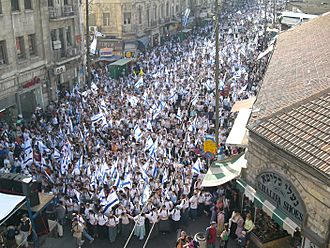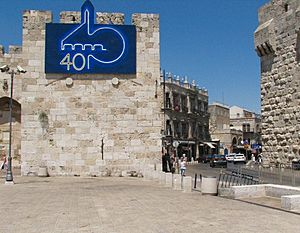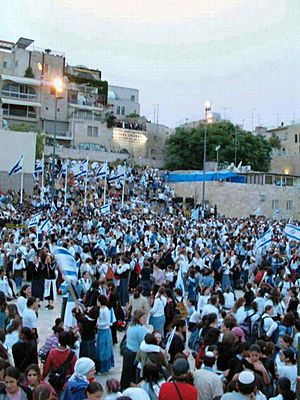Jerusalem Day facts for kids
Quick facts for kids Jerusalem Day |
|
|---|---|

The Israeli Dance of Flags at Jaffa Road, 2007
|
|
| Official name | יום ירושלים (Yom Yerushaláyim) |
| Observed by | Israelis, Jews |
| Type | National |
| Significance | Marks the reunification of East Jerusalem with West Jerusalem under Israel; the first time the whole city came under Jewish rule since the destruction of the Second Temple in 70 CE during the Jewish–Roman wars |
| Celebrations | Dance of Flags |
| Date | 28 Iyar (Hebrew calendar) |
| 2024 date | Sunset, 4 June – nightfall, 5 June |
| 2025 date | Sunset, 25 May – nightfall, 26 May |
| 2026 date | Sunset, 14 May – nightfall, 15 May |
| 2027 date | Sunset, 3 June – nightfall, 4 June |
| Frequency | Annual |
| First time | 12 May 1968 |
Jerusalem Day (Hebrew: יום ירושלים, Yom Yerushaláyim) is an Israeli national holiday that commemorates the "reunification" of East Jerusalem (including the Old City) with West Jerusalem following the Six-Day War of 1967, which saw Israel occupy East Jerusalem and the West Bank, effectively annexing the former. It is celebrated annually on 28 Iyar on the Hebrew calendar, and is marked officially throughout Israel with state ceremonies and memorial services.
A notable celebrations that marks the holiday is a flag-flying parade known as the Dance of Flags. The Chief Rabbinate of Israel declared Jerusalem Day to be a minor religious holiday, as it marks the regaining for Jewish people of access to the Western Wall.
Contents
Historical background

Under the 1947 United Nations Partition Plan for Palestine, which proposed the establishment of two states in British Mandatory Palestine – a Jewish state and an Arab state – Jerusalem was to be an international city, neither exclusively Arab nor Jewish for a period of ten years, at which point a referendum would be held by Jerusalem residents to determine which country to join. The Jewish leadership accepted the plan, including the internationalization of Jerusalem, but the Arabs rejected the proposal.
A civil war between Jewish forces and Palestinian Arabs in Mandatory Palestine internationalized in to the 1948 Arab–Israeli War the day after Israel declared independence and the surrounding Arab states sent their armies in to the former Mandate territory. Jordan captured East Jerusalem and the Old City while Israel captured the western section of the city. Israeli forces made a concerted attempt to dislodge the Jordanians but were unable to do so, and the war concluded with Jerusalem divided between Israel and Jordan by the Green Line. The Old City and the rest of East Jerusalem, along with the entirety of the West Bank, was occupied by Jordan, who forced the Jewish residents out, while the Palestinian Arab residents of western Jerusalem, at the time one of the more prosperous Arab communities, fled widespread looting and attacks by the Haganah, going from 28,000 to fewer than 750 remaining. Under Jordanian rule, half of the Old City's 58 synagogues were demolished and the Jewish cemetery on the Mount of Olives was plundered for its tombstones, which were used as paving stones and building materials.
In 1967, in the Six-Day War, Israel captured and occupied East Jerusalem and the rest of the West Bank from Jordan on 7 June 1967. Later that day, Defense Minister Moshe Dayan declared what is often quoted during Jerusalem Day:
This morning, the Israel Defense Forces liberated Jerusalem. We have united Jerusalem, the divided capital of Israel. We have returned to the holiest of our holy places, never to part from it again. To our Arab neighbors we extend, also at this hour—and with added emphasis at this hour—our hand in peace. And to our Christian and Muslim fellow citizens, we solemnly promise full religious freedom and rights. We did not come to Jerusalem for the sake of other peoples' holy places, and not to interfere with the adherents of other faiths, but in order to safeguard its entirety, and to live there together with others, in unity.
The war ended with a ceasefire on 11 June 1967 with Israel in control of the entirety of territory of Mandatory Palestine, including all of Jerusalem. On 27 June 1967, Israel expanded the municipal boundaries of West Jerusalem so as to include approximately 70 km2 (27.0 sq mi) of territory it had captured in the war, including the entirety of the formerly Jordanian held municipality of East Jerusalem (6 km2 (2.3 sq mi)) and an additional 28 villages and areas of the Bethlehem and Beit Jala municipalities 64 km2 (25 sq mi). On 30 July 1980, the Knesset officially approved the Jerusalem Law, which called the city the complete and united capital.
Celebrations
On 12 May 1968, the government proclaimed a new holiday – Jerusalem Day – to be celebrated on the 28th of Iyar, the Hebrew date on which the divided city of Jerusalem became one. On 23 March 1998, the Knesset passed the Jerusalem Day Law, making the day a national holiday.
One of the themes of Jerusalem Day, based on a verse from the Psalms, is "Built-up Jerusalem is like a city that was joined together" (Psalm 122:3).
In 1977, the government advanced the date of Jerusalem Day by a week to avoid it clashing with Election Day.

The slogan for Jerusalem Day 2007, celebrated on 16 May, marking the 40th anniversary of the reunification of Jerusalem, was "Mashehu Meyuhad leKol Ehad" (Hebrew: משהו מיוחד לכל אחד, 'Something Special for Everyone'), punning on the words meyuhad (מיוחד, 'special') and me'uhad (מאוחד, 'united'). To mark the anniversary, the approach to Jerusalem on Highway 1 was illuminated with decorative blue lighting, which remained in place throughout the year.
In 2015, Yad Sarah a non-profit volunteer organization began organizing a special tour specifically for residents who use wheelchairs, which focuses on Jerusalem history.
The Yakir Yerushalayim (יַקִּיר יְרוּשָׁלַיִם 'Worthy Citizen of Jerusalem') prize is awarded annually by the Jerusalem municipality on Jerusalem day.
50th anniversary
In 2017, the golden jubilee of Jerusalem Day was celebrated. During the course of the year many events marking this milestone took place in celebrations of the 50th Jerusalem Day. Many events were planned throughout the year, marking the jubilee. The main theme of the celebrations is the "Liberation of Jerusalem". The celebrations began during Hanukkah 2016, at an official ceremony held at the City of David National Park in the presence of Minister Miri Regev, who is responsible for the celebrations marking the 50th anniversary. A logo was created for the jubilee and presented by the minister Miri Regev.
Events During the Jubilee Year
The ceremony was held at the City of David National Park at the event the ancient "Pilgrims' Route", that led from the City of David to the Temple Mount during the Second Temple period, was unveiled. The ceremony was attended by Knesset members, mayors and the three paratroopers that were photographed by David Rubinger at the Western Wall in 1967. At the event, the Minister Miri Regev was quoted by the press as saying, "Mr. President Barack Obama, I am standing here, on Hanukka, on the same road on which my forefathers walked 2,000 years ago ... No resolution in any international forum is as strong as the steadfast stones on this street." Noting several of the 14 countries that participated in the resolution – including New Zealand, Ukraine, Senegal, and Malaysia – the minister added, "no other people in the world has such a connection and link to their land."
Significance

While the day is not widely celebrated outside Israel, and has lost its significance for most secular Israelis, the day is still very much celebrated by Israel's Religious Zionist community with parades and additional prayers in the synagogue.
Religious observance
Religious Zionists recite special holiday prayers with Hallel. Although Rabbi Joseph B. Soloveitchik was reluctant to authorise its inclusion in the liturgy, other scholars, namely Meshulam Roth and others who held positions in the Israeli rabbinate, advocated the reciting of Hallel with its blessings, regarding it as a duty to do so. Today, various communities follow differing practices.
Some Haredim (strictly Orthodox), who do not recognise the religious significance of the State of Israel, do not observe Yom Yerushalayim. Rabbi Moshe Feinstein maintained that adding holidays to the Jewish calendar was itself problematic.
In 2015, Koren Publishers Jerusalem published a machzor dedicated to observance of Jerusalem Day and Independence Day.
Ethiopian Jews' Memorial Day
A ceremony is held on Yom Yerushalayim to commemorate the Ethiopian Jews who perished on their way to Eretz Israel. In 2004, the Israeli government decided to turn this ceremony into a state ceremony held at the memorial site for Ethiopian Jews who perished on their way to Israel on Mount Herzl.
See also
 In Spanish: Yom Yerushalayim para niños
In Spanish: Yom Yerushalayim para niños


